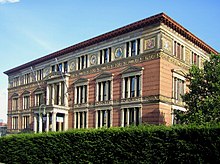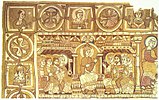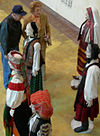


The Kunstgewerbemuseum, or Museum of Decorative Arts, is an internationally important museum of the decorative arts in Berlin, Germany, part of the Staatliche Museen zu Berlin (Berlin State Museums). The collection is split between the Kunstgewerbemuseum building at the Kulturforum (52°30′35″N 13°22′03″E / 52.5097°N 13.3674°E / 52.5097; 13.3674 (Kunstgewerbemuseum, Kulturforum)) and Köpenick Palace (52°26′38″N 13°34′22″E / 52.4439°N 13.5728°E / 52.4439; 13.5728 (Kunstgewerbemuseum, Schloss Köpenick)).
History
It was founded in 1868 as the Deutsches Gewerbe-Museum zu Berlin, and originally had a teaching institute as well as a public museum. The collection grew significantly in the 1870s, and it was renamed Kunstgewerbemuseum in 1879. In 1881 it relocated into the Martin-Gropius-Bau – where Priam's Treasure was also on display for a time – and in 1921 it moved into the Stadtschloss.

Parts of the collection were destroyed in World War II, and the surviving items were split between East and West Berlin. The Eastern collection moved into Köpenick Palace in 1963, while the Western exhibits moved first into Charlottenburg Palace, then into the new museum building in the Kulturforum in 1985, built by Rolf Gutbrod.
Exhibition
The Kunstgewerbemuseum displays European (and Byzantine) decorative arts from all post-classical periods of art history, and features gold, silver, glass and enamel items, porcelain, furniture, panelling, tapestry, costumes, and silks.

There is a very important collection of Late Antique objects in many media. The items from the Middle Ages include a large number of gold reliquaries (including the reliquary arm of St. Caesarius). The Renaissance is represented by silverware from the city councillors of Lüneburg, and bronze sculptures, tapestries, furniture, Venetian glasses and maiolicas from the Italian princely courts.
The Baroque era is represented by faiences from Delft, and glass items. There is also European porcelain (particularly from Meissen and the Royal Manufacturer of Berlin), and decorative crockery from the rococo, classicist, historicist and Art Nouveau styles. The "New Collection" of 20th century craftwork includes industrially-manufactured products.
-
 Fragment of an embroidered tapestry from Halberstadt, around 1170
Fragment of an embroidered tapestry from Halberstadt, around 1170
-
 The Guelph Cross, first half 12th century
The Guelph Cross, first half 12th century
-
Processional cross from Enger
-
Nautilus cup of Aleksander Kęsowski, abbot of Oliwa, 1643-1667
-
 Merseburger Spiegelkabinett, 1712–1715, by Johann Michael Hoppenhaupt I., from the Merseburg palace (today at Köpenick palace)
Merseburger Spiegelkabinett, 1712–1715, by Johann Michael Hoppenhaupt I., from the Merseburg palace (today at Köpenick palace)
-
 Drawing room furniture by Carlo Bugatti, Milan around 1885
Drawing room furniture by Carlo Bugatti, Milan around 1885
See also
- Cloth of St Gereon, the second oldest European wall tapestry still existing
Notes
- Barbara Mundt, Die deutschen Kunstgewerbemuseen im 19. Jahrhundert, Prestel, 1974
- ^ Heute mal Extremitäten Tobias Timm, Die Zeit, 31 August 2009. Retrieved 26 September 2010. (in German)
- Kunstgewerbemuseum Archived 2013-09-24 at the Wayback Machine Berlin State Museums. (in German)
- Kunstgewerbemuseum Archived 2016-03-03 at the Wayback Machine Kulturforum. (in German)
- ^ Museum of Decorative Arts Archived 2007-04-27 at the Wayback Machine (in English)
- Bestandskatalog des Kunstgewerbemuseums Berlin, Volume 4, Stiftung Preußischer Kulturbesitz, Staatliche Museen, Kunstgewerbe Schloss Charlottenburg, 1970
- Martina Junghans: Die Armreliquiare in Deutschland vom 11. bis zur Mitte des 13. Jahrhunderts, Dissertation Bonn (2000), Bonn 2002, Kat.-Nr. 1
- Dietrich Kötzsche, Der Welfenschatz im Berliner Kunstgewerbemuseum, Mann, 1973
- Bilderhefte der Staatlichen Museen, Stiftung Preußischer Kulturbesitz, Volumi 20-21, Mann, 1967
- Bestandskatalog des Kunstgewerbemuseums Berlin, Volume 5, Stiftung Preußischer Kulturbesitz, Staatliche Museen, Kunstgewerbe Schloss Charlottenburg, 1971
- Meissen: Steinzeug und Porzellan des 18. Jahrhunderts, Kunstgewerbemuseum Berlin, Staatliche Museen Preußischer Kulturbesitz, 1980
- Monika Bierschenk, Kunstgewerbemuseum Berlin. Kunsthandwerk vom Mittelalter bis zur Gegenwart, Berlin 1989.
- Marcin Latka. "Abbot Kęsowski's cup". artinpl. Retrieved 26 July 2019.
External links
Map all coordinates using OpenStreetMapDownload coordinates as:
Categories: